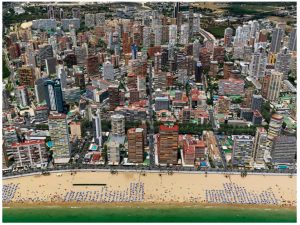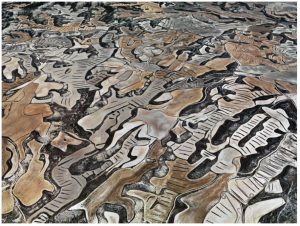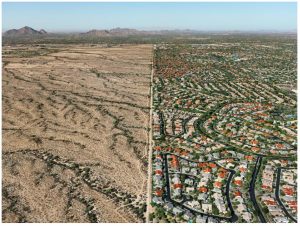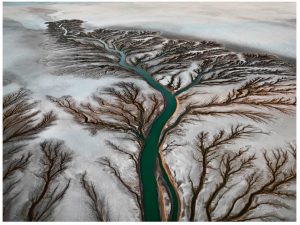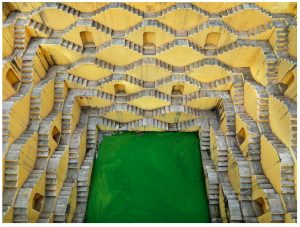
To create the works in his project WATER, Edward Burtynsky (Canadian, born 1955) travelled around the globe, from the Gulf of Mexico to the shores of the Ganges, weaving together an ambitious representation of water’s increasingly fragmented lifecycle. In enormous, color, aerial images, many bordering on the edge of complete abstraction, Burtynsky traces the various roles that water plays in modern life—as a source of healthy ecosystems and energy, as a key element in cultural and religious rituals, and as a rapidly depleting resource.
Many of the images focus our attention not on water itself but on the systems that humans have put in place in order to harness it, shape it, and control it. Photographs of maze-like stepwells in India, massive dam construction and aquaculture in China, manufactured water-front housing lots, and irrigation systems in the American West are presented alongside parched landscapes, dried river regions and ominously-colored salt farms. The photographs are some of Burtynsky’s most abstract images to date: pivot irrigation plots are carefully crafted into totemic arrangements of geometry and dryland farming fields are transformed into dizzying collections of biomorphic forms. These images, sometimes elegant sometimes haunting, hover between the worlds of painting and photography, forming a compelling global portrait of water that functions as an open-ended question about humanity’s past, present, and future relationship with the natural world.
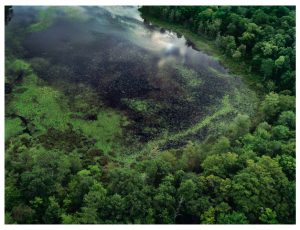
Edward Burtynsky, Georgian Bay #2, Eastern Shore, Ontario, Canada, 2009
Digital chromogenic color print on Kodak Endura Premier Paper, Gift of the artist, 2016.46.13
The image of Canada’s Georgian Bay wetlands, for example, sets the stage: an aerial image of an expanse of water, thick, viscous and obsidian-black in places but punctuated by the flecked and luminous green of plant and algae growth. This is the beginning, the primordial ooze of healthy aquatic life. In this image we are introduced, gently, to what is at stake. The following sequence of pictures gives us the other side of the coin. The soft contours of the wetlands give way to jagged lines and harsh light of the Gulf of Mexico in the aftermath of the 2012 Deepwater Horizon oil spill. Boats sit statically on fields of black, blue, and white, resembling stretched and torn tufts of cotton. The quiet pre-human sentiment of the Georgian Bay image is replaced by a very visibly post-human landscape.
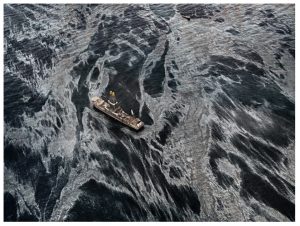
The works then take us over gouged landscapes, fractal patterned delta regions, rigid and rectilinear stepwells, massive circular pivot irrigation plots, aquaculture and social, cultural and ritual gatherings. Water is intermittently introduced as a victim, a partner, a protagonist, a lure, a source, an end, a threat and a pleasure. While the story of water is certainly an ecological one, Burtynsky is more interested in presenting the facts on the ground than in declaring society’s motives good or bad. In focusing on all the facets of people’s relationship with water, Burtynsky offers evidence, without an argument. It is up to us to dive into the deep, to seriously consider the role that we play in the transformation of our relationship to water.
—Russell Lord, Freeman Family Curator of Photographs, Prints, and Drawings
NOMA is committed to uniting, inspiring, and engaging diverse communities and cultures through the arts — now more than ever. Your gift will make a direct and immediate impact as NOMA welcomes our community back to the museum and sculpture garden, plans new exhibitions, and develops virtual and at-home arts education resources for school partners.
